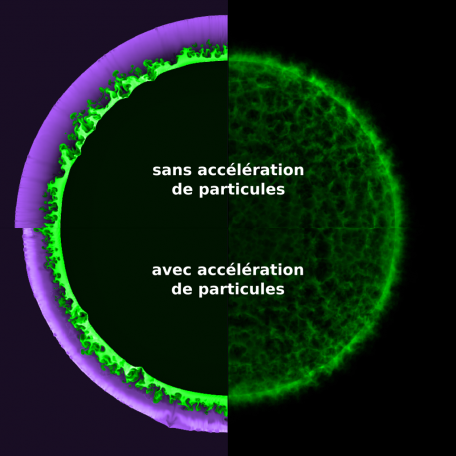For the first time, the events following the explosion of a star have now been simulated in three dimensions by a team from the Astrophysics Division of CEA-IRFU. The simulation includes the significant contribution of particles accelerated by the shock that is produced in the expansion. Until now, these complex simulations have concentrated either on calculating movement of the expanding ejected material, or on calculating particle acceleration. The evolution of the structure resulting from the explosion of the star, which has survived for over 500 years, shows that the accelerated particles appreciably diminish the size of the shock zone. The results can be compared to X-ray observations carried out in 2005 at the position of the stellar explosion observed in 1572 by the Danish astronomer Tycho Brahe. These simulations come from the COAST computer program and they improve our understanding of the complex acceleration mechanisms of "cosmic rays", particles which flood across the Galaxy at velocities approaching the speed of light.
 See the animation of the expansion following explosion of a star
See the animation of the expansion following explosion of a star
 - see the animation of the expansion (Web version)
- see the animation of the expansion (Web version)
 - see the animation of the expansion (mov)
- see the animation of the expansion (mov)
 - see the animation of the expansion (high def version/ mov)
- see the animation of the expansion (high def version/ mov)
For more détails on the method and results, see : Les restes de supernovae accélérateurs de particules (in french)

A 2-D view from a 3-D numerical simulation of a supernova remnant, 500 years after the star's explosion, shows the influence of particles accelerated by the shock wave (above, without particles; below, with particles). The left half of the image shows a cross-section of the remnant, allowing the internal structure to be seen: matter ejected during the explosion is represented in green, and the ambient environment in violet. The particles presence appreciably reduces the thickness of the shock zone and increases its density. The right hand side of the image shows a projection of the square of the density of the heated, ejected matter, which gives an insight into their thermal X-ray emissions. Credits CEA/SAp.
Contacts : ,
Publication : "3D simulations of supernova remnants evolution including non-linear particle acceleration"
Gilles Ferrand (1), Anne Decourchelle (1), Jean Ballet (1), Romain Teyssier (1,2) et Federico Fraschetti (3,4)
(1) Laboratoire AIM, CEA/Irfu, CNRS/INSU, Université Paris VII
(2) Institute for Theoretical Physics, University of Zürich
(3) LUTh, Observatoire de Paris, CNRS-UMR8102 et Université Paris VII
(4) Lunar and Planetary Lab & Dept. of Physics, University of Arizona
Published in the Journal "Astronomy and Astrophysics" , volume 509, January 2010
Download the PDF (380 Ko)
For more information : see the French version
Written by : G. Ferrand, A. Decourchelle, J.M. Bonnet-Bidaud



